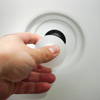With so much hullabaloo around the iPhone 4 "death grip" causing dropped calls, and Apple's recent claims that all phones suffer from this issues, we decided to do some testing on our own. And what better to test with than my current favorite Android phone, the Samsung Vibrant (Galaxy S) from T-Mobile.
As you can see in our video, it was easy to reduce the bars on the Samsung Vibrant from four to one bar with a relatively normal grip along the bottom of the phone. But the Vibrant still had no difficulty making calls.
So I then went to a spot deep inside the building where I had zero bars and then gripped the phone in the same manner, which would have reduced the signal further. Even with "less than zero" bars, our Samsung Vibrant was still able to complete a call.
What this clearly demonstrates is that looking at "bars" is not the best way to evaluate calling ability. In fact, I was able to replicate a significant reduction of bars on other phone models, including my Blackberry Curve 8520, which I used for nearly a year with no dropped call issues.
A little science about cell phone reception
Any time you wrap you hand around a cell phone, you have the potential of blocking the phone's antenna, reducing its ability to receive and transmit signal. Visually, you will notice this as fewer bars on your phone's signal indicator. In areas with a strong signal, interference from your hand won't affect your ability to make calls. But, if the signal is already very weak, calls may be "dropped" or you may not be able to complete a call at all.
But there is more to it than just signal strength. What also matters is the "signal to noise ratio". That is, how strong your phone's signal is relative to all the other signal noise around you (i.e., other people's phones, signal reflections and other types of interference).
This information is all represented within the "bars" at the top of your phone. However, there are no standards among phone manufacturers or cell providers for how the bars should be calculated. So a signal that appears as five bars on one phone could show up as three on another.
But even when your phone indicates you have a strong signal, you may still be out of luck. Richard Gaywood, who has Ph.D in wireless network planning techniques from Cardiff University and has created software that helps cellular operators design their networks for optimum performance, tells us why on his website:
"The bars only indicate how well your phone can listen to the cell tower. They don’t tell you anything about how well the tower can receive your phone, but that’s a pretty important part of making a call.", says Gaywood, "Similarly, the phone doesn’t know anything about what’s going on in the cell provider’s network past the tower; if you’re on a really busy cell it might not have any spare outgoing circuits to direct your call to, so even if the radio is working fine, you might still not be able to get through."
And, what's even more troubling for owners of smartphones is that signal problems also affect your 3G transmission speed. So your calls may be going through, but you're not getting the data bandwidth you're paying for.
What's different about the iPhone 4
Almost all modern cell phones use an internal antenna that can suffer signal loss from your hand under normal use scenarios. But the iPhone 4 has an external antenna that appears to be sensitive to the conductivity of the sweat on your hand, which decreases the level of signal even more when held.
Conclusion
Apple's offer of a free bumper to cover the antenna will resolve the issue of signal loss from contact with the iPhone 4's external antenna, but will not help issues related to "normal" signal loss from gripping the phone or from network congestion and noise.
The fact that so many people are complaining about dropped calls on the iPhone 4 suggests to us that the issue is also with AT&T's network. Dropped calls over AT&T are certainly not a new complaint for owners of the iPhone. And there's no reason to believe that this should have changed with the release of the iPhone 4. But it is worth noting that, according to Gaywood, "Placing calls from my office, my home, and my neighbourhood whilst walking my dogs, I’ve had 14 dropped calls in a little over two hours of talk time." And he is in the United Kingdom, not on AT&T.









From Unreal on July 17, 2010 :: 11:56 am
Who on EARTH holds the phone like that to talk? No normal human being will ever grip a phone like that, and bring it to their ear to talk. The iphone 4 on the other hand, just holding it normally, suffers from the death grip. This is such a desperate attempt in somehow putting Apple, and it’s ‘dear leader’ back up on his high pedestal. It’s just sad that you have to literally try to throw Samsung under the bus…
Reply